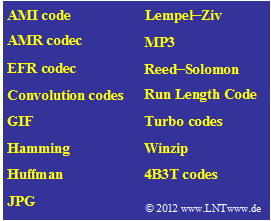Exercise 2.1: Coding with and without Loss
Three types of coding methods are distinguished, namely:
- Line Coding ⇒ Chapter "Coded and Multilevel Transmission" in the book "Digital Signal Transmission",
- Channel Coding ⇒ book "Channel Coding",
- Source Coding ⇒ Chapter "Source Coding - Data Compression" in the book "Information Theory".
All these basic coding methods have in common that the source signal $q(t)$ is represented by a encoded sequence $\langle c_\nu \rangle $. With a digital source (with or w/o memory) the source signal $q(t)$ can be described by the source symbol sequence $\langle q_\nu \rangle $.
At the receiver, the sink symbol sequence $\langle v_\nu \rangle $ or the sink signal $v(t)$ is obtained from the regenerated symbol sequence $\langle r_\nu \rangle $. This is called "decoding", sometimes also "signal reconstruction".
All the terms listed on the right belong to one of the three disciplines listed above, between which there is a certain affinity, but which are quite different in terms of objective and mathematical handling.
A further distinguishing feature in "coded transmission" is:
- One speaks of a "lossless coding procedure", if after decoding $\langle v_\nu \rangle = \langle q_\nu \rangle$ applies.
Otherwise, the coding procedure is called "lossy".
- The prerequisite for this classification is error-free transmission: $\langle r_\nu \rangle = \langle c_\nu \rangle$.
Hints:
- The exercise belongs to the chapter General Description of Source Coding.
- The following questions (3) to (6) refer to the keywords in the above graphic.
Questions
Solution
- In line coding, redundancy is added to adapt the transmitted signal to the spectral characteristics of the channel.
- With channel coding, redundancy is also added specifically, in this case to be able to use it at the receiver for error detection and/or error correction.
- The aim of source coding is to reduce redundancy as much as possible in order to be able to store or transmit the information of the source as efficiently as possible.
(2) Correct answer is 3:
- In line and channel coding, lossy techniques would be counterproductive.
- In contrast, source coding for analog input signals (audio, video, etc.) is lossy per se.
(3) The following are line coding methods:
- the 4B3T codes (there are several variants of this, all of which work in blocks),
- the AMI code (symbol-wise ⇒ at each coding step, a binary character is read in and a ternary character is output).
Consequently, $N_\text{LC}\hspace{0.15cm}\underline{ = 2}$.
(4) In the book "Channel Coding" are dealt with:
- the Hamming codes,
- the Reed-Solomon codes,
- the convolutional codes,
- the turbo codes.
The correct result is accordingly $N_\text{ChC}\hspace{0.15cm}\underline{ = 4}$.
(5) In lossless source coding, the receiver can completely reconstruct the message of the source if no transmission error has occurred.
Lossless source coding schemes include
- the Huffman code,
- the different variants of the Lempel-Ziv algorithm,
- the run-length code,
- the well-known compression programme "Winzip".
All these procedures can only be used with digital input ⇒ $N_\text{SC (lossless)}\hspace{0.15cm}\underline{ = 4}$.
(6) Statements 1 and 3 are correct:
- Only GIF and JPG are applied to pictures. MP3 has been the most widely used audio compression program for years.
- The AMR codec and the EFR codec are used for GSM and UMTS in Mobile Communication.
